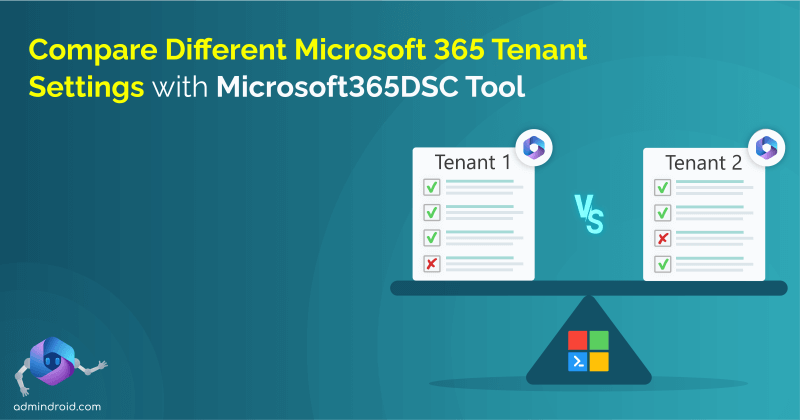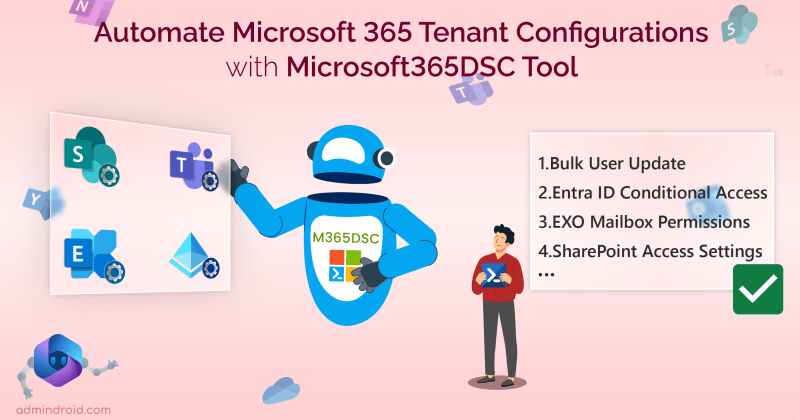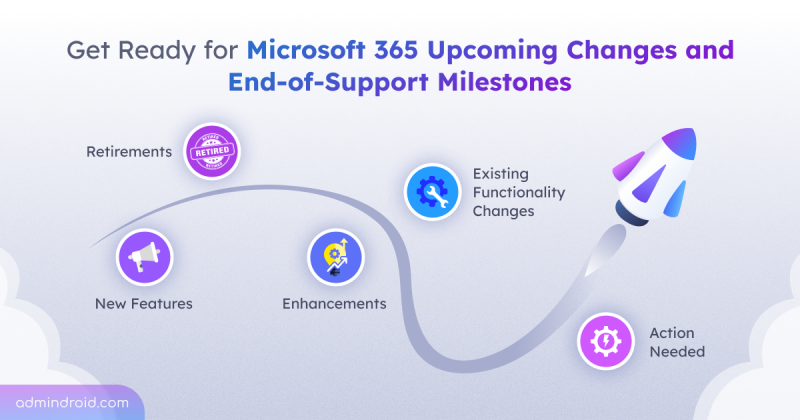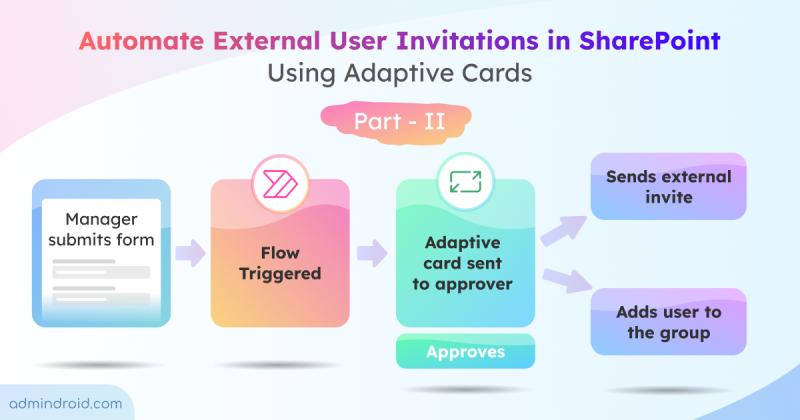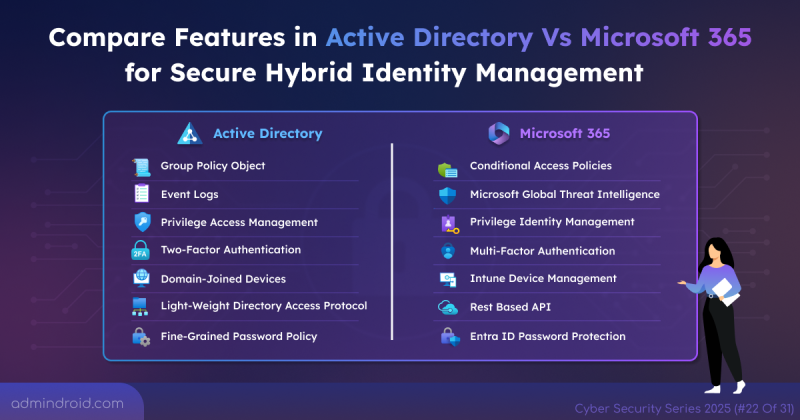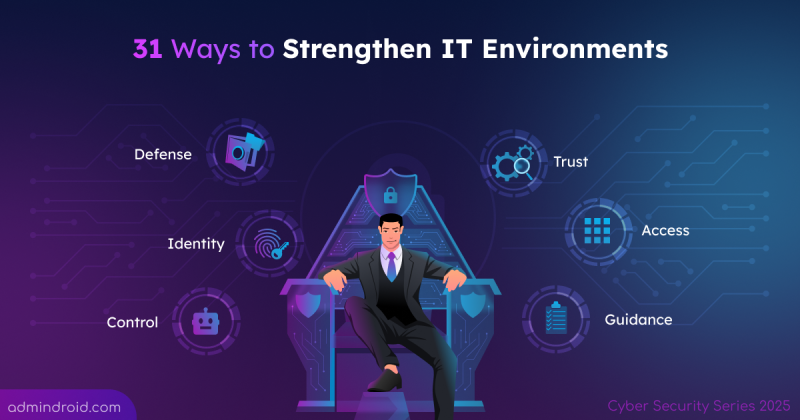The world recognizes October as Cybersecurity Awareness Month and so do we at AdminDroid, with our own tradition of celebrating security. 🛡️
And after 3 years of sticking to this tradition, how could we possibly miss out this year? No way. We’re back, bigger and broader than ever… just like our AdminDroid V6 release! 😉
Here’s a quick look back at the journey of our Cybersecurity series over the years:
- Cybersecurity series 2022: We started by focusing on the essentials and key settings: Microsoft 365 security configurations that are available in the free tiers.
- Cybersecurity series 2023: Took it up a notch with advanced M365 security settings.
- To add some fun, our mornings were filled with Microsoft 365–themed memes that quickly became a crowd favorite.
- Cybersecurity series 2024: Last year, we split the series into two halves:
- 15 days dedicated to Secure Score tips & 15 days of protection measures that aren’t part of Secure Score but are equally important.
- To make it engaging, mornings were packed with quizzes, polls, riddles, and fun questionnaires.
- Now, here we are in 2025…⭐
Cybersecurity Awareness Month: 2025 Series
With fewer than 100 days left in 2025, it’s time to make every day count. This October, we’re turning Cybersecurity Awareness Month into a powerhouse of learning, myth-busting, and practical fixes to strengthen your security posture for the rest of the year and beyond 💪.
This year has been wild for tech, with powerful AI innovations, quantum-safe encryption, and advanced zero-trust models leading the way. Alongside them, AI-driven attacks, autonomous threat detection challenges, and deepfake-powered scams are testing and reshaping the future of cybersecurity!
So, instead of sticking to just one theme, we asked ourselves: why not cover it all? With so much to explore, we’re going beyond the usual focus!
One Myth a Day, Busting What You Believe:
Turning misconceptions into clarity with daily security myth-busters.
Every day at 05:30 AM UTC, we’ll bust a popular security myth, uncover the reality behind it, and share practical fixes you can apply right away. These will be quick, insightful posts designed to spark awareness and keep you one step ahead—follow us on our social channels to stay in the know.
Cybersecurity Spotlight Blog Series:
From legacy AD to modern AI, we’re covering all the security topics that matter most.
No matter if you’re managing on-prem, cloud, or hybrid, there’s something here for you. Promise. Throughout October 1–31, we’ll be publishing daily blogs covering everything as I said.
- Day 8 to 14: AI risk in Microsoft 365
- Day 22 to Day 25: Protecting identities in Hybrid infrastructures
- Day 26 to Day 31: Addressing fundamental security gaps across IT environments
End-to-End Security Controls Across the Microsoft 365 Stack
Over the past year, Microsoft 365 has been evolving rapidly, rolling out smarter collaboration tools, advanced automation, and AI-driven features across productivity and security. But with all this growth, the threats are evolving too! 📈
Misconfigured app permissions, over-permissioned users, and careless file sharing are just a few of the growing tricky spots in Microsoft 365. Threats exploiting these gaps are getting sharper, which means protecting M365 should be as fast and smart as the platform itself! 💯
That’s why, over the first seven days, we’re moving from basic compliance to active risk reduction. We’ll show you how to lock down your environment while keeping productivity smooth and uninterrupted. Check back daily until October 7th for the latest deep dives.
Day 1: Why Setting Office IP as a Trusted Location in Conditional Access Is Risky
This blog highlights the risks of skipping MFA for office networks and trusting locations over identities. Learn safer alternatives like device compliance, risk-based Conditional Access, and Continuous Access Evaluation to strengthen Microsoft 365 security.
Day 2: Block the Creation of Client Secrets in Microsoft Entra Application
Many users still rely on client secrets to authenticate applications because they are convenient. However, these simple string values are easy to mismanage and a prime target for attackers. Therefore, let’s restrict password creation in Entra apps & service principals and adopt safer alternatives like certificate-based authentication.
Day 3: Difference Between Delegated and App-Only Access in Entra ID Applications
This blog highlights the key differences between delegated and application (app-only) permissions in Microsoft Entra ID. Learn how delegated permissions allow apps to act on behalf of signed-in users, while application permissions let apps act independently. Understand the security risks associated with each access scenario and explore the best practices.
Day 4: Create Custom Sensitive Information Types for DLP in Microsoft 365
Microsoft 365 includes sensitive information types for common data such as credit cards and passports, but what about the identifiers unique to your business—like employee IDs or project codes? Even if they don’t look sensitive, a leak could expose employee records or confidential projects. That’s where custom Sensitive Information Types (SITs) in Microsoft Purview come in, helping you extend DLP for these unique identifiers and block these risks. Learn the steps to configure custom SITs in DLP and strengthen data protection.
Day 5: Restrict OneDrive External Sharing to Security Groups in Microsoft 365
If OneDrive external sharing is open to everyone in your organization, you’re giving more access than necessary and that’s a security risk waiting to happen. But wait! Don’t rush to block external sharing completely! Some teams may still need to collaborate with external partners. Instead, you can allow external sharing only for specific security groups. This approach reduces the chance of data leaks while still enabling the right people to collaborate with external partners.
Day 6: How DSPM in Microsoft Purview Helps Protect Sensitive Data
Managing and protecting sensitive data across Microsoft 365 can be a significant challenge. DSPM in Microsoft Purview provides a powerful solution. This guide shows you how to configure DSPM, leveraging its recommendations, analytics, and Security Copilot integration to proactively enhance your data protection.
Day 7: How to Get Entra Enterprise Application Permissions Report
Modern attackers increasingly target non-interactive identities like enterprise applications, which often hold high-privilege permissions through consent. If an attacker compromises any enterprise application, they are able to escalate their privileges, exfiltrate sensitive data, and maintain persistent access to the organization. Therefore, reviewing these enterprise apps’ permissions is essential to prevent such exploitation and maintain strong security oversight in Microsoft Entra.
AI Risk Mitigation and Compliance in Microsoft 365
In the last 12 months, Microsoft has completely leaned into Artificial Intelligence (AI), integrating it everywhere, from security and productivity tools to every solution in the stack.![]()
With these advancements, the threat via AI is evolving just as quickly. AI-driven risks like deepfake engineering, polymorphic and adaptive malware, prompt injection and model manipulation, intelligent IoT/OT exploitation, and AI-generated ransomware negotiation and extortion are emerging. This is just a glimpse of the risks posed by AI, and that list is only getting longer!
To address AI-driven threats, we’ll be sharing practical steps that organizations can implement to manage AI risks.
Day 8: Block Generative AI Using Web Content Filtering in Microsoft 365
Generative AI feels like magic — drafting content, solving code, and even analyzing data in seconds. Yet every bit of convenience hides risks like phishing threats and data privacy. Even more concerning, 93% of admins admit they aren’t fully prepared for what’s underneath. Don’t be one of them! Learn the risks of using AI in your tenant and block unauthorized AI tools with Microsoft Entra web content filtering.
Day 9: Configure Conditional Access Policies to Protect Generative AI Apps in Microsoft 365
According to the 2024 Microsoft Work Trend Index, 75% of global knowledge workers already use generative AI at work. Tools like Microsoft 365 Copilot help employees create, collaborate, and make smarter decisions. But even one compromised account can put your organization’s data at risk, allowing attackers to access Copilot and expose sensitive information. To prevent this, apply Conditional Access policies to ensure only verified users on trusted devices can access Copilot.
Day 10: Restrict AI Apps on Company-Managed Devices in Microsoft 365
Even the most secure company devices can be at risk when AI apps are misused. Not all chatbots, AI problem-solving, or generative AI apps are as safe as users assume—they can leak sensitive data, harvest credentials, or enable phishing attacks. To stay ahead of these threats, restrict and remove AI apps on company-managed devices using Microsoft Intune, and extend protections to BYOD devices for comprehensive security.
Day 11: How to Prevent Users from Uploading Sensitive Data to ChatGPT
With AI now deeply embedded in daily work, the risk of accidentally uploading sensitive files into ChatGPT can’t be ignored. That’s where Global Secure Access (GSA) integration with Netskope ATP and DLP policies in Microsoft Entra comes in. Together, they act as a shield to block sensitive file uploads and safeguard your organization’s data. Learn the step-by-step configurations to keep AI productive without compromising security.
Day 12: Grant Just-In-Time Access to Generative AI apps Using Access Package
Move beyond simply blocking AI applications to implement governed, just-in-time access using Microsoft Entra Access Packages to grant secure, time-bound approvals for essential tools. Access is automatically revoked after a configured period, minimizing the attack surface. This strategy enables productivity while significantly reducing security risks and shadow IT.
Day 13: Detect Microsoft 365 Copilot Interactions Using Communication Compliance Policy
Modern data leakage often occurs when employees send sensitive or proprietary information through AI prompts or receive confidential content in AI-generated responses from services like Microsoft 365 Copilot. If these interactions go unmonitored, they create compliance blind spots, potentially leading to the escalation of sensitive data exposure and . Therefore, implementing a Communication Compliance policy in Microsoft Purview is essential to prevent such exposure and maintain strong regulatory oversight across all AI conversations.
Day 14: How DSPM for AI in Microsoft Purview Helps Monitor & Protect AI Interactions
Every AI interaction – from drafting emails in Copilot to using ChatGPT can put sensitive data at risk. A significant challenge for organizations is insufficient visibility into AI operations: understanding what data is accessed, how it’s processed, and whether employees are uploading confidential content. DSPM for AI in Microsoft Purview addresses this by monitoring AI activity, detecting risky behavior, classifying sensitive data, and providing recommendations and reports — all from a single platform. Learn how to configure it to keep your organization’s data secure.
Hardening Active Directory Against Evolving Threat Vectors
While next-gen threats like hyper-realistic phishing scams and adaptive malware grab the headlines, many organizations are still vulnerable to the classic problem: a completely compromised on-premises account remains a serious threat. 🥷🏼
It’s time to tackle on-premises head-on! Your AD is the backbone of enterprise identity, if it’s weak, everything else fails. 💯This series goes back to basics, focusing on the most critical on-premises configurations. We’ll ensure your ‘keys’ aren’t just locked away; they’re buried deep with advanced measures like Fine-Grained Password Policies and Managed Service Accounts.
Below is the non-negotiable checklist to harden your AD/on-premises environment & keep your accounts and systems protected from attackers.
Day 15: Essential Best Practices for Active Directory Security
Active Directory (AD) is the backbone of enterprise identity, but even a single weak configuration or over-permissioned account can open the door to attackers. Real-world breaches like SolarWinds have highlighted the critical importance of securing Active Directory. To help you strengthen defenses, here’s a practical checklist of 20+ Active Directory security best practices to minimize vulnerabilities and keep your organization resilient.
Day 16: Set Up Fine-Grained Password Policies in Active Directory
Default password policies treat all users the same, which makes admin accounts easy targets for attackers. Fine-Grained Password Policies (FGPP) let you create custom password rules for specific users and groups, enforcing stronger complexity for privileged and sensitive accounts. Learn how to configure FGPP to protect your most critical accounts and elevate your organization’s overall security.
Day 17: Managed Service Accounts: Secure Credential Management in Active Directory
User accounts in Active Directory may seem fine for tasks and services, until expired passwords halt jobs, reused credentials create security gaps, or access goes unchecked. This blog explains how Managed Service Accounts (sMSAs and gMSAs) overcome common risks by automatically rotating passwords and restricting access to authorized computers. Thus, services run reliably while Active Directory remains secure, and manual overhead is reduced.
Day 18: Delegation Wizard for Active Directory Least Privilege
When too many users have excessive access, your Active Directory becomes an open door for mistakes and attacks. That’s why it’s essential to give the right people the right permissions. Discover how to implement Least Privilege in Active Directory using the Delegation of Control Wizard to keep your environment secure and well-managed.
Day 19: How to Reset KRBTGT Account Password in Active Directory
Unchanged KRBTGT account password poses a serious risk, acting as a master key that lets attackers forge Kerberos tickets and access your entire Active Directory domain. Resetting the KRBTGT password invalidates existing forged credentials and helps prevent Golden Ticket attacks. Learn how to reset the KRBTGT password to safeguard authentication across all your Domain Controllers and strengthen your domain’s security.
Day 20: How to Set Up Honey Accounts in Active Directory
Attackers often begin by probing accounts and systems to find weak entry points. Without proper monitoring, these reconnaissance attempts can go unnoticed until it’s too late. Deploying honeypot accounts helps you detect such activity early by luring attackers toward decoy accounts and revealing their presence before any real damage occurs. Implementing honeypot accounts in Active Directory strengthens your threat detection strategy and enhances overall domain security.
Day 21: Prevent Users from Adding Computers to the Domain Using Group Policy
Hidden Active Directory configurations can possess major security risks: by default, any authenticated user can join up to 10 computers to the domain, creating pathways for unauthorized devices that may bypass security controls, spread malware, or expose data. Controlling domain-join capabilities through proper user rights assignments and Group Policy reduces these risks and strengthens your Active Directory security.
Protecting Identities in Hybrid Infrastructures
Alright, we have now seen both edges; cloud and on-prem, and that’s great! But the reality is, almost no business is 100% on-prem anymore. The reality is that users and resources are split, some are still in that AD, and some are in the cloud, often managed by Microsoft Entra ID. This is the Hybrid Infrastructure, and this split is exactly where attackers look for gaps!🔍
It’s not enough to secure your on-premises AD alone! ❌Threats can hop from cloud systems back into your network, which makes protecting identities in hybrid environments a real challenge. The key is making sure your on-prem and cloud systems work together securely.
Further, we’ll cover essential strategies to protect critical admin accounts and counter hybrid identity attacks.
Day 22: Active Directory Vs Microsoft 365 Features for Hybrid Identity Management
Managing identities across Active Directory and Microsoft 365 introduces security gaps such as standing administrative privileges, inconsistent access controls, and exposure to legacy authentication attacks. Understanding how each platform’s features operate is essential for implementing effective security controls and minimizing risks in hybrid environments. This blog compares the security capabilities of both platforms and provides best practices to secure hybrid environments against identity-based threats.
Day 23: Best Practices to Secure Admin Accounts in Hybrid Environment
Admin accounts are prime targets for attackers, making their protection a top priority in hybrid environments. Safeguarding these accounts is essential to prevent breaches and maintain full control over your infrastructure. Explore 10 essential best practices to secure privileged accounts, reduce exposure, and strengthen your hybrid security posture.
Day 24: Enable Passwordless Authentication in Hybrid Domains with Microsoft Entra Kerberos
Passwords remain the weakest link in hybrid domain security, easily phished or cracked to breach both cloud and on-premises resources. By adopting passwordless authentication with Microsoft Entra Kerberos, you can eliminate phishing threats, ransomware, etc. This allows users to access domain resources with their face, fingerprint, or a security key—credentials that cannot be stolen. Configure passwordless authentication to strengthen your entire identity foundation, providing phishing-resistant security for your hybrid environment.
Day 25: Protect Microsoft Hybrid Environment Against Identity Attacks
The Microsoft Hybrid Environment, connecting on-premises Active Directory and cloud Entra ID, presents a complex and frequently targeted attack surface. Protecting this crucial trust boundary is essential to prevent lateral movement and large-scale breaches. Explore most critical attacks and their prevention steps to maintain full security control over your hybrid identity infrastructure.
Addressing Fundamental Security Gaps Across IT Environments
Alright, let’s zoom out a bit. 🔍We’ve tightened up the cloud with AI, hardened AD, and secured hybrid identities. But if your general IT security still has gaps, even the best AD hardening won’t be enough!
So, in this section we are going to be totally environment-agnostic. It’s not about Microsoft licenses or AD schema; it will be about closing the most common entry points that attackers love to exploit.
From getting strict about who has remote access to local admin risks, we’ll help you with the best practices.
Day 26: Best Methods to Securely Store Passwords for Automated PowerShell Scripts
Storing passwords in automation PowerShell scripts whether hard-coded or plaintext can lead to unauthorized access, privilege escalation, and data breaches. But how can you automate without exposing your passwords? This blog explores how to address these risks by securely storing credentials using different methods to ensure automated workflows remain safe and compliant.
Day 27: Top 11 Remote Desktop Access Best Practices
Remote Desktop makes working from anywhere seamless, but unsecured sessions can expose your computer to attackers and data theft. Exposed ports, weak passwords, outdated software, and insufficient access controls can all add up, creating openings for malicious actors. Learn how to secure your remote connections with 11 essential security best practices.
Day 28: Restrict Remote PowerShell Access to Non-Admins
By default, administrators and members of the Remote Management Users group have permission to use PowerShell Remoting. However, if these configurations are modified, non-admin users may unintentionally gain remote access, allowing them to run powerful cmdlets that could lead to data exposure or privilege escalation. To eliminate this risk, it’s crucial to restrict PowerShell Remoting exclusively to administrators. In this guide, you’ll learn how to restrict remote PowerShell access for non-admins and keep your systems safe from unauthorized connections.
Day 29: Best Practices to Protect Local Admin Accounts in Windows
Local administrator accounts are among the most dangerous vulnerabilities in endpoint security. They give attackers a direct path to deploy ransomware, move laterally, and maintain persistent control. Therefore, it’s critical to manage them effectively and close the paths attackers exploit. Learn the key security risks and best practices to protect your local admin accounts and drastically reduce your attack surface.
Day 30: VPN Security and the Shift Toward Zero Trust Access
Virtual Private Networks (VPNs) have long been trusted to secure remote access and protect online privacy by encrypting data and masking IP addresses. However, in today’s Zero Trust era, not all VPNs provide the same level of protection. While secure VPNs can protect your data, free or outdated ones may record your activity, leak your IP address, or use weak protocols that put your security at risk. This blog explores how VPNs work, what truly makes them secure, where they can fall short, and how modern solutions like ZTNA and SASE are redefining the future of secure connectivity.
Day 31: Best Practices of Personal Data Protection
Employee’s personal data represents more than compliance; it reflects trust, responsibility, and respect. Misconfigured permissions, unmanaged devices, or careless sharing can expose sensitive details and erode that trust. This guide brings together 10 essential best practices every admin should follow to safeguard employee information, uphold compliance, and protect the people behind the data.
Each post will build on the last, giving you practical ways to strengthen security across Microsoft 365, AI, Active Directory, hybrid, and beyond.
See you in the next update, until then, stay secure! 🛡️

